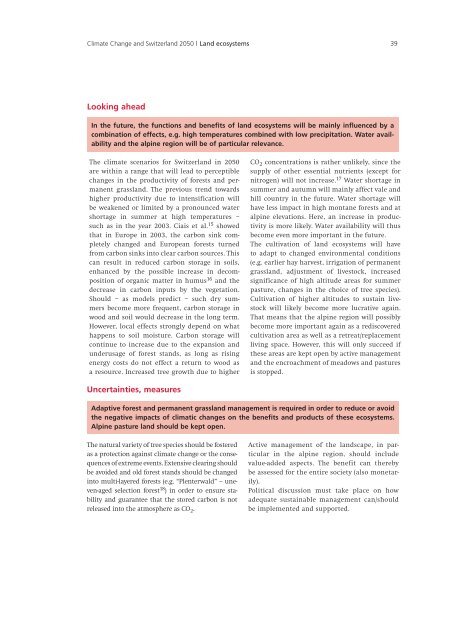Climate Change and Switzerland 2050 - OcCC - SCNAT
Climate Change and Switzerland 2050 - OcCC - SCNAT
Climate Change and Switzerland 2050 - OcCC - SCNAT
Create successful ePaper yourself
Turn your PDF publications into a flip-book with our unique Google optimized e-Paper software.
<strong>Climate</strong> <strong>Change</strong> <strong>and</strong> Switzerl<strong>and</strong> <strong>2050</strong> | L<strong>and</strong> ecosystems 39<br />
Looking ahead<br />
In the future, the functions <strong>and</strong> benefits of l<strong>and</strong> ecosystems will be mainly influenced by a<br />
combination of effects, e.g. high temperatures combined with low precipitation. Water availability<br />
<strong>and</strong> the alpine region will be of particular relevance.<br />
The climate scenarios for Switzerl<strong>and</strong> in <strong>2050</strong><br />
are within a range that will lead to perceptible<br />
changes in the productivity of forests <strong>and</strong> permanent<br />
grassl<strong>and</strong>. The previous trend towards<br />
higher productivity due to intensification will<br />
be weakened or limited by a pronounced water<br />
shortage in summer at high temperatures –<br />
such as in the year 2003. Ciais et al. 15 showed<br />
that in Europe in 2003, the carbon sink completely<br />
changed <strong>and</strong> European forests turned<br />
from carbon sinks into clear carbon sources. This<br />
can result in reduced carbon storage in soils,<br />
enhanced by the possible increase in decomposition<br />
of organic matter in humus 16 <strong>and</strong> the<br />
decrease in carbon inputs by the vegetation.<br />
Should – as models predict – such dry summers<br />
become more frequent, carbon storage in<br />
wood <strong>and</strong> soil would decrease in the long term.<br />
However, local effects strongly depend on what<br />
happens to soil moisture. Carbon storage will<br />
continue to increase due to the expansion <strong>and</strong><br />
underusage of forest st<strong>and</strong>s, as long as rising<br />
energy costs do not effect a return to wood as<br />
a resource. Increased tree growth due to higher<br />
Uncertainties, measures<br />
The natural variety of tree species should be fostered<br />
as a protection against climate change or the consequences<br />
of extreme events. Extensive clearing should<br />
be avoided <strong>and</strong> old forest st<strong>and</strong>s should be changed<br />
into multi-layered forests (e.g. “Plenterwald” – uneven-aged<br />
selection forest 18 ) in order to ensure stability<br />
<strong>and</strong> guarantee that the stored carbon is not<br />
released into the atmosphere as CO 2.<br />
CO 2 concentrations is rather unlikely, since the<br />
supply of other essential nutrients (except for<br />
nitrogen) will not increase. 17 Water shortage in<br />
summer <strong>and</strong> autumn will mainly affect vale <strong>and</strong><br />
hill country in the future. Water shortage will<br />
have less impact in high montane forests <strong>and</strong> at<br />
alpine elevations. Here, an increase in productivity<br />
is more likely. Water availability will thus<br />
become even more important in the future.<br />
The cultivation of l<strong>and</strong> ecosystems will have<br />
to adapt to changed environmental conditions<br />
(e.g. earlier hay harvest, irrigation of permanent<br />
grassl<strong>and</strong>, adjustment of livestock, increased<br />
significance of high altitude areas for summer<br />
pasture, changes in the choice of tree species).<br />
Cultivation of higher altitudes to sustain livestock<br />
will likely become more lucrative again.<br />
That means that the alpine region will possibly<br />
become more important again as a rediscovered<br />
cultivation area as well as a retreat/replacement<br />
living space. However, this will only succeed if<br />
these areas are kept open by active management<br />
<strong>and</strong> the encroachment of meadows <strong>and</strong> pastures<br />
is stopped.<br />
Adaptive forest <strong>and</strong> permanent grassl<strong>and</strong> management is required in order to reduce or avoid<br />
the negative impacts of climatic changes on the benefits <strong>and</strong> products of these ecosystems.<br />
Alpine pasture l<strong>and</strong> should be kept open.<br />
Active management of the l<strong>and</strong>scape, in particular<br />
in the alpine region, should include<br />
value-added aspects. The benefit can thereby<br />
be assessed for the entire society (also monetarily).<br />
Political discussion must take place on how<br />
adequate sustainable management can/should<br />
be implemented <strong>and</strong> supported.

















